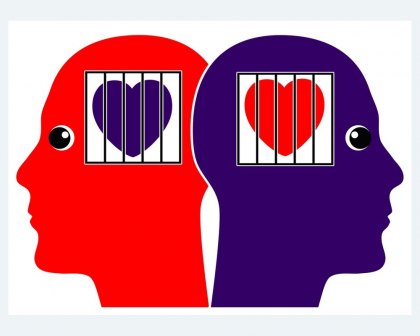An apology for the Lavender Scare

The department, he said, was among public and private employers that discriminated based on “perceived sexual orientation” dating back to the 1940s but continuing for decades. Some employees were forced to resign. In other cases, applicants were never hired. “These actions were wrong then,” Kerry said, in making the apology, “just as they would be wrong today.”
The period Kerry refers to is also known as the Lavender Scare. In the 1950s, lavender was associated with gay men, writes historian David K. Johnson in the book, The Lavender Scare: The Cold War Persecution of Gays and Lesbians in the Federal Government (University of Chicago Press; 2006). The expression "lavender lads" referred to gay men.
The Lavender Scare overlaps with the second Red Scare -- the fear of communist activities within U.S. borders in the years following World War II. Here is a compressed account of the Lavender Scare, along with sources and links for further study:
The War: During World War II, homosexual men and women served in the military, despite anti-homosexual policies, writes Allan Berube in the book, Coming Out Under Fire, The History of Gay Men and Women in World War II (University of North Carolina Press; 2010). Afterward, they began looking for gathering places.
Push back: In 1947, the U.S. Park Police in Washington initiated a "Sex Perversion Elimination Program, targeting gay men for arrest and intimidation,” recounts the National Archives. “A year later, Congress passed an act ‘for the treatment of sexual psychopaths’ in the nation's capital. That law facilitated the arrest and punishment of people who acted on same-sex desire and also labeled them mentally ill.”
Enter, Dr. Kinsey: In 1948, Alfred Kinsey, a professor of zoology at Indiana University, along with Wardell B. Pomeroy and Clyde E. Martin, research associates, published Sexual Behavior in the Human Male (Indiana University Press). The authors described male behavior, asserting, “A considerable portion of the population, has at least some homosexual experience between adolescence and old age.”
Enemies from within: In a speech Feb. 9, 1950, in Wheeling, West Virginia, Sen. Joseph McCarthy asserted that he had a list of 205 “known communists” who worked for the State Department. Later that month, he gave another number -- 81 -- while on the Senate floor. McCarthy said two cases involved homosexuality, according to the National Archives.
While testifying before a congressional committee, John Peurifoy, deputy undersecretary for the State Department, was reluctant to discuss the dismissal of homosexuals. This “inadvertently drew attention to the subject. Homosexuals and communism were quickly conflated, and a purge of gays and lesbians from the department occurred during the height of McCarthyism,” according to the account, McCarthyism and The Cold War, on the State Department website. “The Office of Security set up the M (Miscellaneous) Unit to investigate cases of suspected homosexuals.”
The department’s personnel director wanted to avoid the appearance of a witch hunt, the report said. Even so, the department fired “54 people it considered to be homosexuals in 1950, 119 in 1951, and 134 in 1952.” Comparatively fewer employees were fired for “straightforward security concerns,” the report said: “12 in 1950, 35 in 1951, and 70 in 1952.” In 1953, the M unit’s work resulted in the firing of 99 employees.
Executive action: On April 27, 1953, President Dwight D. Eisenhower issued an executive order authorizing investigations to "develop information as to whether the employment or retention in employment in the federal service of the person being investigated is clearly consistent with the interests of the national security." The list of criminal, immoral or unethical behaviors included “sexual perversion.”
Separately, the State Department report said gay and lesbian employees were considered security risks because they could be blackmailed.
The Franklin Kameny case: In 1957, Frank Kameny, a World War II veteran who held a doctorate from Harvard, took a job with the U.S. Map Service. Within a year, he was arrested by the “morals squad” in Washington's Lafayette Park, a gay cruising ground, recounts Kameny’s 2011 obituary in The New York Times. Kameny was fired from his job. He appealed the firing in court but ultimately lost. Afterward, he became an determined gay rights advocate.
Sources:
- Coming Out Under Fire, The History of Gay Men and Women in World War II by Allan Bérubé, (University of North Carolina Press; 2010).
- National Archives: Congressional investigations and the Lavender Scare.
- The Lavender Scare: The Cold War Persecution of Gays and Lesbians in the Federal Government by David K. Johnson (University of Chicago Press; 2006).
- Sexual Behavior in the Human Male, Alfred Kinsey, a professor of zoology at Indiana University, Wardell B. Pomeroy and Clyde E. Martin, research associates (Indiana University Press; 1948).
- The New York Times: Franklin Kameny, gay rights pioneer, dies at 86.
- University of Chicago: An interview with David K. Johnson, author of The Lavender Scare.
- U.S. Department of Labor: Frank Kameny, Fought to end discrimination in the federal workforce, to be honored with induction in Labor Hall of Honor.
- U.S. Department of State: Secretary John Kerry’s apology.
- U.S. Department of State: McCarthyism and the Cold War.
Related:
Testimony sheds light on Rosenberg case
Follow StudyHall.Rocks on Twitter.
If you would like to comment, give us a shout, or like us on Facebook and tell us what you think.

